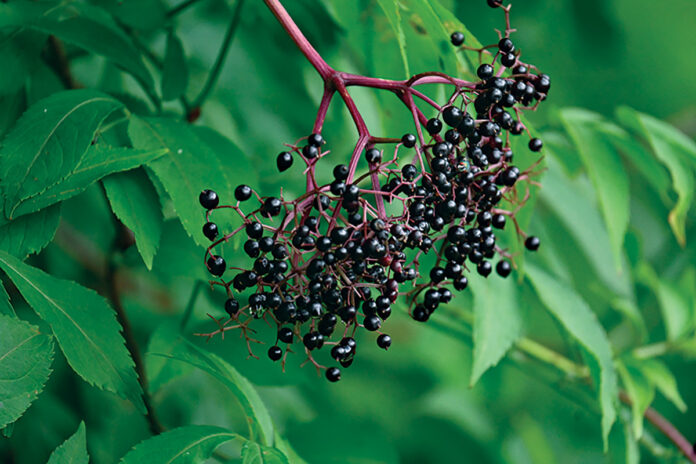I have an annual tradition that I anxiously await. Every year, I kick off our county fair in late August by visiting the grange booth for a piece of elderberry pie. There are so many flavors from which to choose, all baked by the members, but for me, ordering that piece of elderberry has become one of my favorite ways to celebrate the event. I’ll also have you know, that I don’t eat elderberry pie at any other time of the year, as it would take away from this special experience, which I savor. That’s not to say that I don’t enjoy elderberries in other ways, because I do.
Elderberries

There are two species of elderberry that commonly occur in the United States: the American elderberry (Sambucus canadensis) and the European black elder (S. nigra). Though similar in appearance, the American elderberry (a native species) is smaller and shrub-like, attaining a height of up to 10 feet and growing just as wide. The European black elder (non-native) attains heights of up to 20 feet and appears as a small tree. Although these two species occur naturally, there are many cultivars available on the market that offer a variety of advantageous attributes.
Elderberries are fast-growing and prefer moist, well-drained soil with full or partial sun. They can be recognized by their large, serrated compound leaves. As summer progresses the plant develops large, fragrant, creamy-white flower heads. Closer examination of these compound clusters reveals a wide, umbrella-like structure containing many individual flowers, each with five petals. Each distinct flower depends on a pollinator in order for it to produce a single black fruit. The fragrant blossoms, known as “elderflowers,” are as popular as the fruit for which the plant is known.

Uses
Flowers are often harvested to make fritters, cordials and tea while the bunches of revered, shiny, black berries are collected for use in making syrup, jelly, wine and pies.
Elderberry comes with a long history of medicinal uses throughout many cultures and today, elderberry products are a common and popular item on store shelves. Research has proven that the flowers and berries are loaded with vitamins and antioxidants that boost the immune system, easing cold and flu symptoms. Elderberries are high in dietary fiber, they temper inflammation, help with stress and strengthen heart health.
Yet, before you jump on the elderberry bandwagon, be aware that all parts of the plant are extremely poisonous, and that the flowers and berries (the only edible components) must be cooked thoroughly in order for them to be rendered safe for consumption. If you are unsure about how to prepare wild-harvested elderberry, it is best to obtain it from the safety of a shop.
Red-berried elder

There is another elderberry native to this area that blooms and fruits much earlier in the year. Red-berried elder (Sambucus racemosa) can be spotted in mature forests, especially along woodland streams. The cone-shaped flower heads bloom in May, their striking ruby-colored fruit maturing shortly thereafter adding a head-turning splash to the landscape. It is thought that this species is even more toxic than black elderberries, so it is best to simply enjoy the shrub visually and let the wildlife fully benefit from the plant’s bounty.
Elderberry borer beetle

Over the years, I have planted several American elderberry plants that are thriving on our farm. I love to walk among them, taking in the fragrance of the blossoms and checking on their progress. One day I caught my breath at the sight of a large, extremely handsome beetle perched atop one of the leaves. The specimen was that of an elderberry borer beetle (Desmocerus palliates). At just over an inch in length, it sported a metallic blue body with yellow bands resembling the pattern of a wasp. It was stunning. Unfortunately, most people would not share my enthusiasm for this insect that regularly lays its eggs near the base of the plant. Upon hatching, the larvae burrow into the stem and down into the roots, weakening or even killing the plant eventually. Luckily choosing healthy plants that are disease-free will greatly reduce the likelihood of attracting these beetles and to date, none of my plants have ever suffered from this insect.
As I type this, a big bowl of harvested berries sits in the fridge awaiting processing. As I did last year, I will place them in a dehydrator for a few days and use the dried berries to create a syrup that’s rich in nutrients. Then I will force myself to consume a teaspoon of this delicious mixture daily in an effort to keep the doctor away.
In past years, when there was an overabundance of elderberries across the landscape, we have made elderberry wine — its gorgeous color and potency unmatched by any other homemade spirits. Early next spring, as my plants are just beginning to bud, I will take cuttings, anchoring them firmly in several choice areas and expanding my bounty. It certainly seems like no matter what the time of year, Mother Nature always has something delicious to offer, and right now, it’s elderberry time!


















Elderberry pie is my absolutely favorite. My maternal grandma, Magdalena Ley Madick made the best, my mom’s was in 2nd place.
Cleaning the elderberries to satisfy grandma was a job. No stems allowed,not one. She made jelly and pies. We all ate the berries as we cleaned them and no one died from poisoning?! Never knew they need to be cooked to be safe. Whenever we go somewhere that serves Elderberry pie I get a slice, maybe once a year. It brings back memories but is never as good as Grandma Lena’s.
A super big thank-you and an A+++ for inserting all the wonderful pictures you place within your articles.